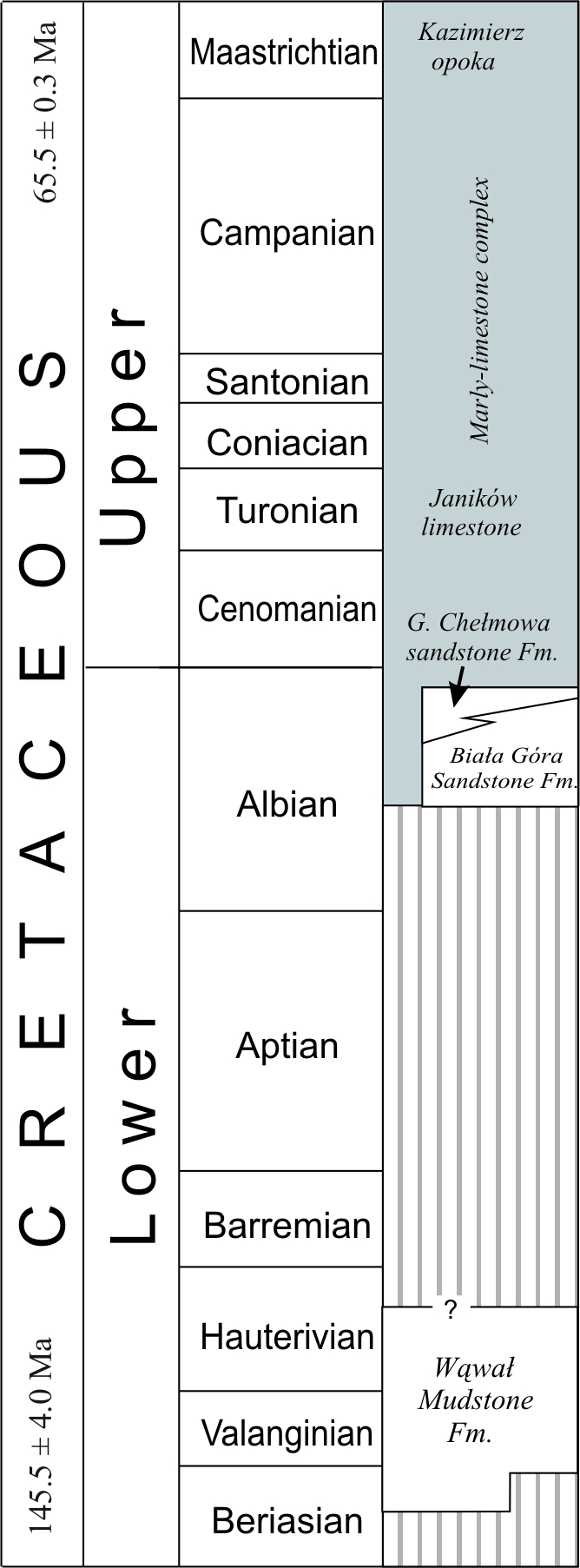Author of the elaboration: prof. dr hab. Bronisław Matyja
Cretaceous deposits belong to two, mostly marine, sedimentary-diastrophic stages. The first one, with a duration of c. 16 Ma, is a continuation of the Middle Jurassic transgression and in the Cretaceous encompasses the lower parts of the system (Berriasian to Hauterivian). The second stage includes Albian to Maastrichtian deposits and was c. 36 Ma long. Both stages are separated by 17 to 21 Ma of structural reorganization, known as the Neo-Cimmerian phase, separating the older Neo-Cimmerian sedimentary-diastrophic stage from the younger Laramide stage.
Lower Cretaceous deposits have been recognized in the Tomaszów Syncline in the north-eastern margin and in the basement of the Carpathian Foredeep.
In the Tomaszów Syncline, Cretaceous sedimentation began with conglomerates composed of limestone clasts, and clays and mudstones (Kutek et al. 1989), which disappear to the south and were eroded prior to the Albian transgression (Fig. 10)

Fig. 10. Simplified lithostratigraphic scheme of the Cretaceous in the Mesozoic margin of the Holy Cross Mountains (after Tabela Stratygraficzna Polski [Stratigraphic Chart of Poland] 2008)
The thickness of these discontinuous Berriasian and Valanginian (Hauterivian?) deposits did not exceed 20 m. The poorly dated deposits between the Valanginian and Upper Albian are 150 m thick (Poręba 1987) and are usually considered Middle Albian in age.
Directly below the Miocene deposits of the Carpathian Foredeep, and beneath the Carpathian overthrust, was recently identified (Dziadzio et al. 2004; Urbaniec et al. 2010) a vast area of thick (at least 188 m), Lower Cretaceous deposits (Zagorzyce 1 Borehole), belonging to the Berriasian and Valanginian, and probably also to the Hauterivian. The area between the present-day Tomaszów Syncline and the area of the Carpathian Foredeep is at present devoid of Cretaceous strata. However, the Tethyan affinities of the ammonite fauna from the sections located north of the Holy Cross Mountains allow us to conclude (Kutek et al. 1989) that there was a connection between both areas and that sedimentation also took place in the Early Cretaceous in the area of the present-day Holy Cross Mountains (compare also Cieśliński 1976). Sediment removal resulted from the uplift of a parallel block, termed the Meta-Carpathian Swell (Nowak 1927) or the Vistula Ridge (Cieśliński 1976). The reconstruction of the area linked with the Neo-Cimmerian phase resulted here in long-term erosion, or at least non-deposition, from part of the Hauterivian until the Early Albian.
The Cretaceous transgression, linked with the second sedimentary-diastrophic stage, covered the area gradually in Albian and Cenomanian times. Cretaceous deposits from this new stage that are preserved in the Mesozoic margin are separated from the Jurassic strata by a minor, but distinct on a regional scale, angular unconformity and a profound stratigraphic gap. In the exposures described, the gap is documented in Małogoszcz Quarry (Chapter 3.22) and in the Zajęcza Góra exposure. At the latter site a distinct angular unconformity between the Cenomanian and the underlying strata is visible.
Clastic deposits beginning a new stage of marine sedimentation appeared at different stratigraphic intervals. In the Tomaszów Syncline and in the Rachów succession within the north-eastern margin they appeared in the Middle Albian, in the south-western margin in the Late Albian (Małogoszcz succession), or even in the Early Cenomanian (Zajęcza Góra). This diachronous appearance of the basal transgressive strata was related to the variable basement morphology, and on a regional scale to the uplift of the Silesian-Cracow and Sudetic lands after the Neo-Cimmerian movements. For example, a large area devoid of Albian sediments was postulated along the south-western margin; it encompassed a large part of the Miechów Syncline between Radomsko and Cracow (Hakenberg and Świdrowska 1998).
The maximum thickness of the transgressive Cretaceous clastic deposits occurs at the north-western margin. The succession includes sands with clay intercalations (Biała Góra Sandstone Formation), deposited in a shallow sub-tidal environment (Marcinowski and Rudowski 1980), where they are up to 150 m thick. Towards the south, the sands or their uppermost parts pass into limonitic sands and sandstones (Góra Chełmowa near the town of Przedbórz) and contain ammonites of the Mortoniceras inflatum Zone (Chlebowski et al. 1978). Further along the south-western margin, the thickness of the Albian decreases to disappear completely. In the north-eastern margin, the clastic transgressive deposits also thin out to the south, but still contain Albian and Cenomanian ammonites. In Annopol upon Vistula occur sandy deposits of the Middle and Upper Albian, covered by sandy glauconitic marls, encompassing the condensed Cenomanian and reaching the lowermost Turonian. According to Marcinowski and Radwański (1983), their source area was the Meta-Carpathian Swell, which supplied coarse-grained material both into the Carpathian flysch basin and into the area of the present-day Mid-Polish Uplands. The degree of pre-Albian erosion increased to the south, but more significantly from east to west. Within the Miechów Synclinorium, in the Polish Jura Chain, and largely in the Fore-Sudetic Monocline, transgressive deposits from the Lower/Upper Cretaceous boundary lie on progressively older Jurassic and Triassic rocks.
The change of sedimentation from clastic- to carbonate-dominated took place by the end of the Early Turonian (Marcinowski and Radwański 1983). At that time, facies unification can be observed for a large part of Poland (Walaszczyk 1992). From the Late Turonian till the earliest Palaeocene, opokas with flints dominate in the north-eastern margin, and more marly facies (marls and gaizes) in the south-western margin. Both facies are located within a deeper shelf. The chalk facies prevailed to the north-east of the opoka facies, following the margin of the East European Craton.
The maximal thickness of the Upper Cretaceous in the Miechów Syncline reaches slightly above 1000 m, and in the Puławy segment of the Kościerzyna-Puławy Synclinorium – over 1500 m (Krassowska 1997). Thickness variations for the top of the Maastrichtian are observed, indicating uplift of the Mid-Polish Swell; basins located to the south-west (Nida Basin) and north-east (Puławy Basin) of the Mid-Polish Swell started to form at this time (Narkiewicz and Dadlez 2008).
Regression of the marine basin took place at the end of the early Palaeocene.



